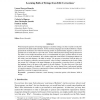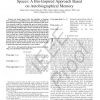462 search results - page 46 / 93 » Modelling Human Intelligence: A Learning Mechanism |
ATAL
2009
Springer
14 years 2 months ago
2009
Springer
This paper presents a model of neural network embodiment of intentions and planning mechanisms for autonomous agents. The model bridges the dichotomy of symbolic and non-symbolic ...
ECML
2007
Springer
14 years 2 months ago
2007
Springer
When facing the question of learning languages in realistic settings, one has to tackle several problems that do not admit simple solutions. On the one hand, languages are usually...
TSMC
2010
13 years 2 months ago
2010
In Smart Spaces (SSs), the capability of learning from experience is fundamental for autonomous adaptation to environmental changes and for proactive interaction with users. New re...
ANTSW
2010
Springer
13 years 5 months ago
2010
Springer
Division of labour in multi-robot systems or multi-robot task allocation (MRTA) is a challenging research issue. We propose to solve this MRTA problem using a set of previously pub...
ATAL
2004
Springer
14 years 1 months ago
2004
Springer
Multi-agent research often borrows from biology, where remarkable examples of collective intelligence may be found. One interesting example is ant colonies’ use of pheromones as...


